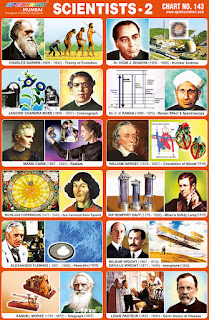 |
| Scientists 2 Charts |
Spectrum Chart - 143 : Scientists 2
- Charles Darwin - Charles Darwin, was an English naturalist and geologist. He is famous for his work on the theory of evolution. Darwin published his theory of evolution with compelling evidence in his 1859 book On the Origin of Species. Darwin has been described as one of the most influential figures in human history.
- Dr. Homi Bhabha - Homi Jehangir Bhabha was an Indian nuclear physicist, founding director, and professor of physics at the Tata Institute of Fundamental Research. Colloquially known as "father of the Indian nuclear programme".
- Jagdish Chandra Bose - Jagadish Chandra Bose, was a polymath, physicist, biologist, biophysicist, botanist and archaeologist, as well as an early writer of science fiction. He also invented the crescograph. He also pioneered the investigation of radio and microwave optics, made very significant contributions to plant science.
- Dr. C. V. Raman - Chandrasekhara Venkata Raman was an Indian physicist, who carried out ground-breaking work in the field of light scattering, what now is called the 'Raman Effect', which earned him the 1930 Nobel Prize for Physics. In 1954, India honoured him with its highest civilian award, the Bharat Ratna.
- Marie Curie - Marie Curie was a Polish and naturalised-French physicist, chemist and feminist who conducted pioneering research on radioactivity. She created a theory of radioactivity, found different ways for separating radioactive isotopes and discovered two new elements, radium and polonium. She was also the first woman to win a Nobel Prize as well as the first person to win two Nobel Prizes.
- William Harvey - William Harvey was an English physician who made seminal contributions in anatomy and physiology. He was the first known to describe completely and in detail the systemic circulation and properties of blood being pumped to the brain and body by the heart i.e. circulation of blood.
- Nicolaus Copernicus - Nicolaus Copernicus was a Renaissance mathematician and astronomer who formulated a model of the universe that placed the Sun rather than the Earth at the center of the universe. The publication of this model in his book De revolutionibus orbium coelestium. His formula of how the sun, rather than the earth, is at the centre of the solar system, is still one of the most important scientific hypotheses in history. It was the beginning of modern astronomy.
- Sir Humphry Davy - Humphry Davy, was a Cornish chemist and inventor, who is best remembered today for his discoveries of several alkali and alkaline earth metals, as well as contributions to the discoveries of the elemental nature of chlorine and iodine. In 1815, he invented the miner's lamp to be used by miners in mines.
- Alexander Fleming - Sir Alexander Fleming was a Scottish biologist, pharmacologist and botanist. He is best known for discovering the antibiotic substance penicillin in 1928. He won a Nobel Prize in Physiology or Medicine in 1945. His discovery of penicillin had changed the world of modern medicine by introducing the age of useful antibiotics; penicillin has saved, and is still saving, millions of people around the world.
- Wilbur Wright & Orville Wright – The Wright brothers, Orville and Wilbur, were two American brothers, inventors and aviation pioneers who are credited with inventing, building and flying the world's first successful airplane. They designed, built and flew the first controlled, powered, heavier-than-air airplane on December 17, 1903.
- Samuel Morse - Samuel Morse was an American painter and inventor. After having established his reputation as a portrait painter, Morse contributed to the invention of a single-wire telegraph system based on European telegraphs. He was also a co-developer of the Morse code and helped to develop the commercial use of telegraphy.
- Louis Pasteur - Louis Pasteur was a French microbiologist and chemist.He is best known for his experiments supporting the Germ theory of disease and he is also known for his vaccinations, most notably the first vaccine against rabies. He made many discoveries in the field of chemistry, including the asymmetry of crystals. He is also well known for his way of keeping milk and wine from going sour for longer periods of time. That process is called pasteurization.

No comments:
Post a Comment